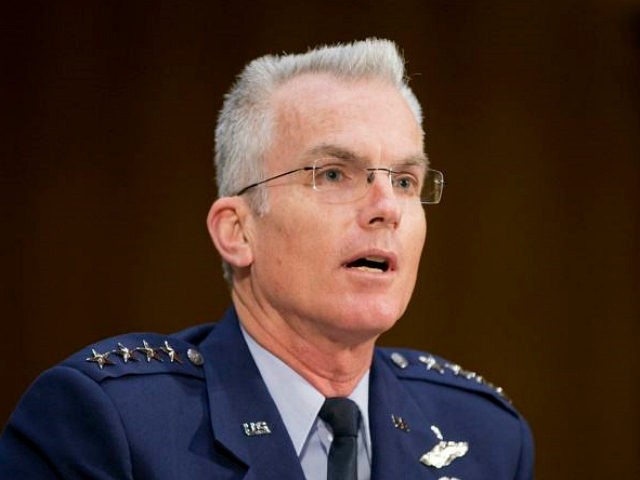The U.S. military cannot afford to wait when it comes to modernizing and recapitalizing America’s nuclear capabilities, the vice chairman of the Joint Chiefs of Staff told lawmakers.
In written testimony prepared for Wednesday’s House Armed Services Committee hearing on the military assessment of nuclear deterrence requirements, Air Force Gen. Paul Selva, the vice-chairman, noted that the armed forces had placed nuclear deterrence, including weapons, infrastructure, and personnel, at the top of their modernization priorities list.
He added:
Nuclear modernization can no longer be deferred. Previous decisions to defer modernization have resulted in overlapping acquisition programs today, which present two major consequences.
First, any disruption to the current program of record or future acquisition plans will introduce risk to our strategic [nuclear] deterrent… Second, the cost of funding modernization and replacement of the entire nuclear enterprise all at once is substantial.
Current projections already show that the Pentagon is expected to increase spending on the nuclear deterrent by billions, from about 3 percent (nearly $20 billion) of its fiscal year 2016 budget to more than double (6.5 percent) the amount in the late 2020s when the budget is likely to be higher.
“Despite these risks and costs, there is no higher priority for the Joint Force than fielding all components of an effective nuclear deterrent, including weapons, infrastructure, and personnel,” Selva told lawmakers.
“The fundamental role of U.S. nuclear forces is to deter a strategic attack against the United States, its allies, and its partners,” he added. “Simply put, nuclear weapons pose the only existential threat to the United States and there is no substitute for the prospect of a devastating nuclear response to deter that threat.”
Although the general stressed that it is high time to overhaul American’s nuclear capabilities, he noted that the United States is currently capable of responding to an unforeseen emergency.
Gen. Selva pointed out that Russia and China pose the top strategic nuclear threats to the United States but added that the inventory of adversaries is growing.
“No one should doubt that our weapons, delivery systems, the infrastructure that supports them, and the personnel who operate, monitor, and maintain them are prepared today to respond to any contingency,” he declared. “Our current challenge, however, is to maintain this high level of readiness and capability as long as the policy and strategy of this nation depends in part on nuclear weapons for its security.”
Currently, the U.S. military’s nuclear deterrent capabilities stand near a crossroads.
“We are now at a point where we must concurrently recapitalize each component of our nuclear deterrent,” explained the general during his verbal testimony. “The nuclear weapons themselves, the triad of strategic delivery platforms, the indication-and-warning systems to support our decision processes, the command-and-control networks that connect the president to our field forces, and our dual-capable tactical aircraft that can be equipped with nonstrategic nuclear weapons.”
For more than two decades, the U.S. military has been forced to defer some nuclear force modernization to deal with other more urgent needs while ensuring that the country’s nuclear capabilities and infrastructure remain safe, reliable, and secure.
“In making those decisions we have squeezed about all the life we can out of the systems we currently possess,” Selva told lawmakers. “So that places an extra premium on a very deliberate long-term investment strategy to replace those systems as existing systems age out of the inventory.”
Air Force Gen. John Hyten, the commander of U.S. Strategic Command, testified alongside Selva.
He noted that other nations, including U.S. adversaries, have continued to modernize and revamp their nuclear abilities as America squeezes the life out of its nuclear weapons stockpile, delivery systems, and other essential infrastructures at a time when the U.S. is facing unpredictable threats posed by the current multi-domain, multi-challenge security environment.
“Maintaining strategic deterrence, assurance and escalation control capabilities requires a multifaceted long-term investment approach and a sustained commitment to maintaining a credible nuclear deterrent,” noted Gen. Hyten, adding that “nuclear deterrent is only as effective as the command and control that enables it to function.”
Nuclear weapons continue to play a significant role in keeping the U.S. homeland safe.
Nevertheless, America has drastically reduced “the role and prominence of nuclear weapons in our defense planning” and “both the number of deployed weapons and the overall size of our stockpile” since the end of the Cold War, testified ret. U.S. Air Force Gen. Robert Kehler before the Senate Armed Services Subcommittee on Strategic Forces.
In his written testimony, he noted that “shaped by presidential initiatives and arms reduction agreements, by 2018 the number of weapons deployed on triad systems will be barely one‐tenth of Cold War highs.”

COMMENTS
Please let us know if you're having issues with commenting.